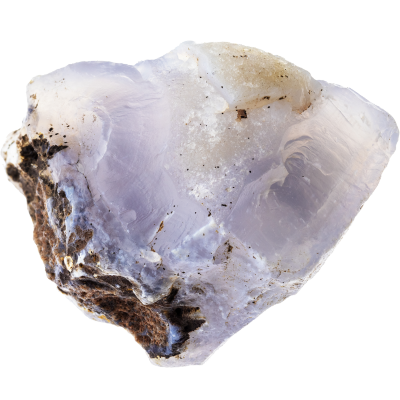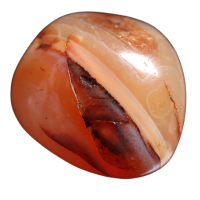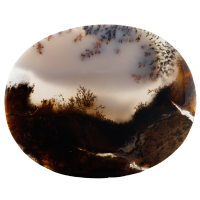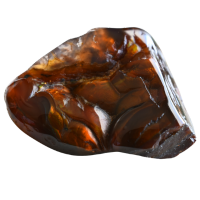Chalcedony Meaning: Varieties, Healing Properties and Uses

Explore the meaning of Chalcedony, its colorful varieties, and its healing benefits for your emotional and spiritual health.
Chalcedony, a stunning gem, offers a range of colors and shapes. Known for its healing and spiritual benefits, it brings peace, balance, and emotional healing, harboring energies that enhance well-being and spiritual growth.
As someone who values clear communication and creativity, I find Chalcedony's supposed enhancement in these areas particularly intriguing. Its connection to various chakras, especially the throat chakra, aligns with my interest in fostering better self-expression and emotional balance. Whether utilized for its beauty or alleged metaphysical properties, Chalcedony remains a stone of fascination and utility.
What is Chalcedony?
Chalcedony, a silica consisting of quartz and moganite, is known for its nurturing properties. It's a stone that promotes brotherhood and goodwill, fostering group stability. Traditionally, it assists in telepathic communication and aligns the body's energy centers, emphasizing the mind and spirit.
The stone has been associated with various healing properties:
- Emotional balance: Chalcedony is believed to soothe and foster mental stability.
- Communication: It is said to improve the ability to express ideas confidently.
- Generosity and kindness: This gemstone is often used to foster these qualities.
I understand that Chalcedony is linked with the upper chakras, particularly affecting areas of communication. This connection is thought to help with articulating thoughts and feelings, and it's claimed to provide a sense of safety when expressing oneself.
As a gemstone with diverse colors and patterns, Chalcedony's meaning extends to its aesthetic versatility, making it popular in jewelry and as a decorative item. Each variation brings its unique qualities to the forefront, contributing to the gemstone's overall sense of nurturing and support.
Geological Formation
In exploring Chalcedony's geological formation, I uncover how this mineral evolves from a unique interplay of chemical components and environmental conditions.
Mineral Composition
Chalcedony is a form of silica, predominantly comprising silicon dioxide (SiO2). It's a type of cryptocrystalline quartz, meaning the crystals are too tiny to be seen by the naked eye. This mineral results from solidifying silica-rich solutions percolating through porous and volcanic rocks. Due to its microscopic quartz crystals, it's structurally more complex than it appears.
Global Deposits
Chalcedony is found worldwide, with its deposits not confined to any geographic location. Key locations include:
- Brazil: Source of varied chalcedony types.
- United States: Notably in Oregon and Arizona, primarily yielding agates and jaspers.
- India: Carnelian and other varieties are shared here.
- Madagascar: Known for unique patterns and colors of Chalcedony.
These global occurrences show that chalcedony formation transcends borders, echoing the vast reach of volcanic and sedimentary processes.
Physical Characteristics
In this section, I will explore the distinct physical properties of Chalcedony, a mineral noteworthy for its diverse colors and fine structure. Comprised primarily of quartz, Chalcedony is known for its cryptocrystalline composition, which contributes to its unique clarity and luster.
Color Varieties
Chalcedony occurs in a vast spectrum of colors, each variety often known by a specific name:
- Blue Chalcedony: Soft to vivid blue.
- Green Chalcedony: Ranges from light to dark green.
- Pink Chalcedony: Delicate pink, often translucent.
- Red Chalcedony: Known as carnelian when red to reddish-brown.
- Black Chalcedony: Deep, solid black.
- White Chalcedony: Opaque to translucent white.
- Brown Chalcedony: From light brown to nearly black, described as sard when darker.
- Orange Chalcedony: Bright orange to reddish-orange.
- Yellow Chalcedony: Pale yellow.
- Purple Chalcedony: Light to rich purple, commonly called chalcedony jasper.
Transparency and Luster
Chalcedony's characteristic luster is best described as waxy to vitreous. The mineral's translucency varies depending on its specific form:
- Translucent: Allows light to pass through, but not detailed images.
- Semi-Transparent: Objects are vaguely visible through the stone.
Cleavage and Fracture
In terms of its structure:
- Cleavage: Chalcedony has no cleavage, meaning it does not break along flat planes.
- Fracture typically exhibits a conchoidal or uneven fracture, a breakage resembling a shell's concentric ripples.
Chalcedony Varieties
Chalcedony encompasses various gemstones known for their beautiful colors and patterns. Each variety has distinctive traits catering to collector's and jewelry enthusiasts' preferences.
Agate

Agate is notable for its concentric bands of color, often seen in layered formations. Its diversity in appearance, from transparent to opaque, makes each piece unique.
Sardonyx

Sardonyx combines alternating layers of sard and onyx, presenting a blend of reddish hues with white or black bands. It is cherished for its intricate patterns.
Onyx

Onyx is typically recognized by its parallel bands of black and white, although it can also be found in solid black or other colors. It is favored for its sleek, sophisticated appearance.
Chrysoprase

Chrysoprase exhibits a vibrant green color due to the presence of nickel. My appeal in this gemstone lies in its bright, apple-green hues that often symbolize growth and health.
Jasper

Its opacity and grainy composition distinguish Jasper. This variety comes in many colors, frequently featuring landscape-like patterns.
Moss Agate

Moss Agate is not technically an agate since it lacks the typical banding. Instead, it contains green mineral inclusions resembling moss, providing a distinct, natural appeal.
Blue Lace Agate

Characterized by its soft blue banded patterns, Blue Lace Agate exudes a calming presence. It's my recommendation for those seeking a subtle color with intricate designs.
Bloodstone

Traditionally, Bloodstone is dark green with specks of red, thought to resemble blood. Its historical connection to health and protection makes it a gemstone shrouded in lore.
Botswana Agate

This variety is known for its fine banding and rich, warm colors. The intricate band patterns often remind me of the intricate lines found in a topographic map.
Carnelian

Carnelian's warm, reddish hues range from orange to deep red. This is one of my favorite stones for its vibrant and energy-inducing color.
Dendritic Agate

Dendritic Agate features tree or fern-like inclusions known as dendrites. These unique markings create miniature landscapes within each stone.
Petrified Wood

Petrified Wood is a form of Chalcedony that has replaced the organic material in Wood, capturing the wood grain in a fossilized state. It's a fascinating example of nature's alchemy.
Plasma
Plasma is a deep green variety of opaque Chalcedony that may include small spots of Jasper or other minerals. It's often used in carvings and seals.
Fire Agate

Fire Agate is rare and valued for its iridescent properties. It reflects fiery luminescent colors, like the play of colors seen in opal.
Holly Blue Agate
Holly Blue Agate is prized for its clear to opaque shades of blue. Its serene color is reminiscent of a tranquil sky.
Metaphysical Properties
My exploration into the metaphysical properties of Chalcedony reveals its reputed ability to harmonize the mind, body, and spirit. This stone is celebrated for its calming energy, which fosters emotional balance and enhances mental faculties.
Emotional Healing
Chalcedony is often sought for its gentle energy that nurtures emotional stability. It's believed to diminish negative emotions such as rage and despair, replacing them with a sense of calm and balance. Users of this stone credit it with the ability to enhance their confidence and strength, fostering a more positive internal dialogue.
Spiritual Use
Regarding spiritual applications, Chalcedony is said to foster communication and creativity. This makes it a favorite among those looking to heighten intuition and deepen their understanding of the spiritual realm.
I've learned it's also used to aid in grounding, providing a stable base to explore spiritual growth.
Physical Well-Being
Although not a substitute for medical treatment, users claim that Chalcedony promotes general physical well-being and bolsters energy. It's affiliated with protection and luck, offering a shield against negativity while inviting prosperity.
Some attribute to it the power to enhance courage, which may contribute to overall vitality and enthusiasm for life.
How to Use Chalcedony

Chalcedony, with its variety of colors and forms, is not just a stone to admire for its beauty. I use it for several purposes, ranging from emotional balance to decorating my living space.
Here's how I incorporate this stone into my life:
Emotional Support:
- Meditation: I hold Chalcedony during meditation to promote emotional balance and mental clarity.
- Stress Relief: Carrying a piece of Chalcedony with me reminds me to stay calm during stressful times.
Physical Energy:
- Workout Enhancement: I sometimes keep Chalcedony close by when exercising to increase my physical energy.
Communication:
- Speeches and Presentations: Placing Chalcedony on my desk helps focus my thoughts, which is particularly useful when preparing to speak or present.
Jewelry:
- Daily Wear: Wearing chalcedony jewelry not only accessorizes my outfit but also allows me to benefit from its properties throughout the day.
The diverse applications make Chalcedony a multifaceted tool in my daily routine. Its subtle, soothing energy makes it a staple in my collection of crystals.
Caring For Chalcedony Stones
Taking care of my chalcedony stones is essential to maintain their luster and longevity. Here's my straightforward approach to keeping them in top condition:
Daily Maintenance:
- Handling: I always make sure to handle my Chalcedony with care to prevent any scratches or chips.
- Storage: Separately storing each piece prevents them from rubbing against harder gemstones, which could cause damage.
Cleaning Process:
- Warm, Soapy Water: I gently wash my Chalcedony with a soft brush in warm water and mild soap.
- Rinse: After scrubbing, I ensure it's thoroughly rinsed to remove any soap residue.
- Dry: I pat it dry with a soft, lint-free cloth.
Avoidances:
- Chemicals: I keep my Chalcedony away from harsh chemicals that can erode the stone.
- Temperature Extremes: Sudden temperature changes are to be avoided as they can cause fractures.
- Ultrasonic Cleaners: They're too harsh for Chalcedony and can potentially damage the stone.
Regular Inspections:
- I check the setting of my chalcedony jewelry to ensure the stone remains secure.
- If I spot any scratches or blemishes, I visit a professional jeweler for potential re-polishing.
By following these care steps, I managed to preserve the beauty and integrity of my chalcedony stones.
Final Thoughts
In exploring the diverse aspects of Chalcedony, I've found it to be a gemstone with a rich tapestry of meanings and properties. My interaction with Chalcedony has shown its reputed ability to foster emotional balance, offering a sense of control in expressing feelings and thoughts.
I value how Chalcedony is perceived to bring mental clarity, especially during information overload or external pressure. Its connection to creativity is intriguing, opening the mind to new ideas and nurturing innovation and imagination.
From my perspective, the protective qualities associated with black Chalcedony add depth to this mineral family. The belief that it shields against negative energies resonates with many who seek emotional stabilization.
As a stone of harmony, it embodies a universal equilibrium, aligning the body, mind, and spirit. In my examination, I appreciate Chalcedony's supposed capacity to harmonize and heal, recognizing its perennial allure in various cultures and traditions.
Frequently Asked Questions
This section will address common inquiries regarding Chalcedony, its types, meanings, and significance.
What are the various types of Chalcedony?
Chalcedony encompasses a wide family of gemstones, including but not limited to pure Chalcedony (also known as Sard or Carnelian), the green variety Chrysoprase, banded Agate, Red Jasper-spotted Heliotrope, and banded Onyx.
How is green Chalcedony different in meaning?
Green Chalcedony, mainly known as Chrysoprase, is believed to embody growth, healing, and fertility. It is associated with the heart chakra, emphasizing its connection to compassion and kindness.
What are the uses and significance of Chalcedony?
Chalcedony stones are prevalent in jewelry-making and various decorative arts. Beyond aesthetics, they bear significant meaning - promoting stability, harmony, and nurturing in social relationships and personal reflection.
Can you explain the spiritual significance of blue Chalcedony?
Blue Chalcedony is often connected to the throat chakra and is thought to aid communication and expression. Spiritually, it is associated with tranquility, imparting a sense of peace and enhancing the ability to listen and understand.
What are the healing benefits associated with chalcedony stones?
Chalcedony provides various healing benefits, such as fostering mental balance, alleviating negative emotions, and enhancing physical endurance. However, these benefits are anecdotal and must be supported by scientific evidence.
How is Chalcedony referenced or represented in biblical texts?
In biblical texts, Chalcedony is mentioned in the Book of Revelation as one of the twelve foundation stones of New Jerusalem. Its presence symbolizes purity and the representation of the tribes of Israel.

